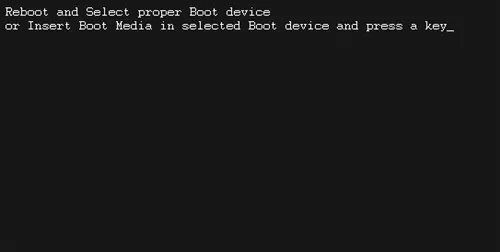It can be quite panicking when you turn on your computer to perform a task and encounter the error message “Reboot and select a proper boot device” just as the machine was starting up. In such scenarios, even rebooting the computer multiple times does nothing to fix it, and you cannot fix the issue from within the Windows OS because the machine doesn’t even boot. So what do you do?
Don’t worry, issues like these can usually be resolved in no time. We are here to guide you through several solutions that you can apply to resolve the said problem. First, let us see what error message this occurs in the first place.
Table of Contents
Why “Reboot and select proper boot device” error occurs
Once you shut down your PC normally and the next day when you try to boot it up again, you are confronted with a black screen asking you to select a boot device. What causes this issue?
The “Reboot and select a proper boot device” error is prompted when your system cannot find a device with an executable operating system on it. Even though an OS has been installed on the hard disk and was fully functional just yesterday, it sometimes becomes dysfunctional due to several reasons. These reasons could be both due to hardware and software.
Hardware
The hardware-related reasons could be:
- The hard disk is undetectable due to a damaged cable (power or SATA).
- The hard disk is detected but isn’t connected properly.
- The bootable disk has been damaged or is dead.
Software
The software-related reasons for the error could be:
- The bootable partition is no longer active.
- The boot sequence is incorrectly configured.
- The boot files have been corrupted.
- OS has been corrupted
Now that we understand why the error occurred, we have a few tricks up our sleeves to fix it.
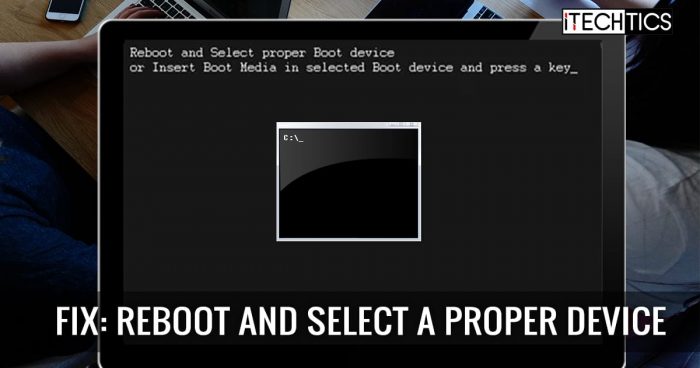
Fix “Reboot And Select A Proper Boot Device” Error
Check for cables physically
If your machine was running perfectly fine the last time and suddenly stopped working causing the error, you should initially inspect the wires connecting the hard drive. Disconnect your system’s hard drive and check the wires for any physical signs of damage. It could be possible that the wires overheated or just accumulated some carbon on the connectors.
NOTE: Disconnect your computer's power cable and battery (in case of a laptop) before opening it up.
Inspect the wires, reconnect them and check to see if you still encounter the same problem. If you do however find a problem with the wires, we suggest that you replace them immediately.
Check if boot drive is detected
The next step is to check if the hard drive is being detected by the system at all. For that, you can verify it through their BIOS. Follow the steps below to do so.
Enter your system BIOS and look for the peripherals your system detects. This information is usually on the main BIOS page. Check to confirm if your hard drive is being displayed as an item that is currently detected by your BIOS.
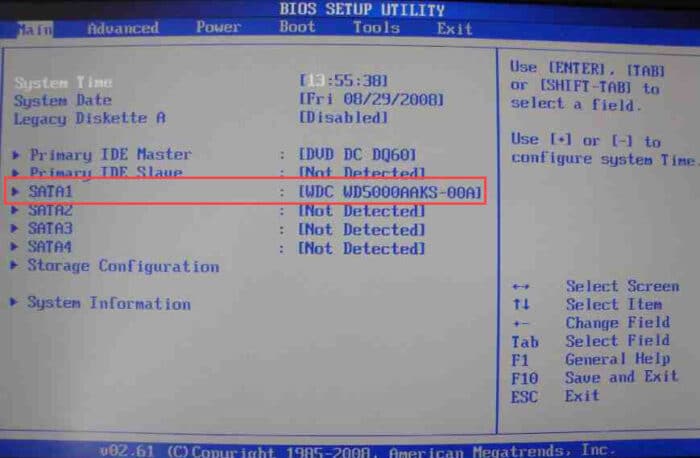
If you find that your hard drive is not being listed, shut down your computer and change the slot it is connected to on the motherboard’s side then recheck if it is detected in the system BIOS. If still not, then try replacing the cables connected to the hard drive.
If you are still unsuccessful, then it is likely that you have a dead hard drive.
Rearrange boot order in BIOS
If you do see your hard drive in the system BIOS, then make sure that it is at the top of the boot order. The boot order decides where devices take priority in running the operating system from. Therefore, ensuring that the boot drive is at the top will ensure that the system is not trying to boot an OS from another device, such as the CD ROM or a USB drive.
Enter your system BIOS and head to the “Boot order” configurations. Each BIOS may have a different location for this setting, therefore you might have to look around for it. When found, change the boot order to bring the hard drive to the top or the “first boot device” using either the up arrow key or the + key.
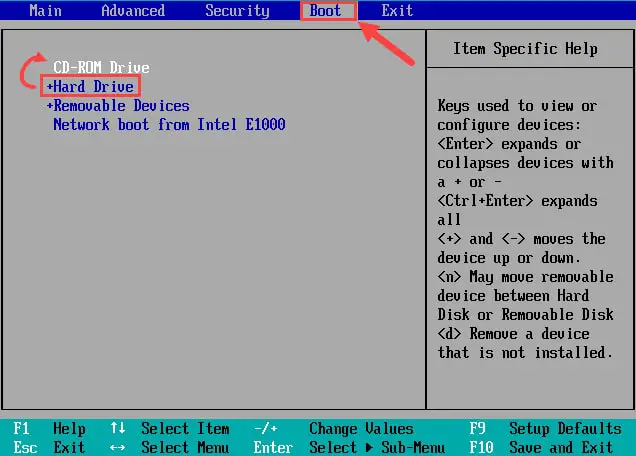
Enable/Disable Legacy Boot mode
There is a chance that your hard drive’s partition type/style does not support the mode your BIOS uses to boot an operating system. Since Legacy Boot mode only supports MBR, it is possible that it has been switched off. In contrast, it is also likely that the partition mode is GPT which requires UEFI.
Tip: Learn more about Legacy vs. UEFI boot modes here, and MBR vs. GPT here.
To enable or disable Legacy Boot mode, reboot your computer and enter the system BIOS. Now look for the Boot mode option. This can be found in different locations for the different BIOS types. Once found, if it is already enabled, disable it. If it is disabled, try enabling it and rebooting the computer.
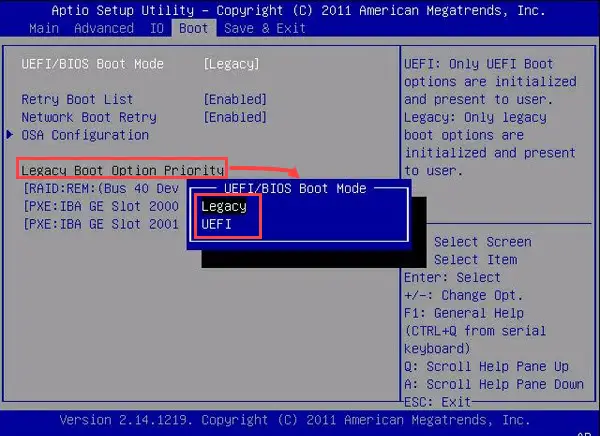
Try booting it from the hard drive again and check if it does.
Load optimal defaults for BIOS
If your issue has not been resolved thus far, we suggest that you restore your BIOS settings to the default factory settings. Often, any misconfigured BIOS settings could be preventing it to boot up from the hard drive successfully.
Enter your system BIOS and look for the “Load default settings” option. Restore the default settings and then reboot the computer to check if the OS boots from the hard drive.
Activate system partition
Another reason for the “Reboot and select a proper boot device” error could be that the partition that holds the OS has suddenly gone inactive, and is thus unable to load it. This can be enabled using the Command Prompt.
To do this, bootable installation media will be required. Create a bootable Windows device using the media creation tool and plug it in. Then boot from the bootable external device and click Repair your computer. From there, navigate to the following:
Troubleshoot -> Advanced options -> Command Prompt

In the Command Prompt, type in Diskpart. Then, type in list disk to confirm the number of disks on your PC, and then select the correct one by typing in select disk 0 (or the correct number of the disk as per your list).
Once selected, type in list partition to confirm the number of partitions. Then type in select partition 1 (or the correct number of the OS partition) and then type active to activate it.

Now restart the computer to check if it boots into the OS.
Repair BCD files
BCD files are important for the system to run and boot up smoothly. It is possible that these files have been corrupted and need some fixing up. You can repair these by following the guide given below.
To do so, create a bootable USB drive and boot from it using the boot menu at startup. From there, click Repair your computer.
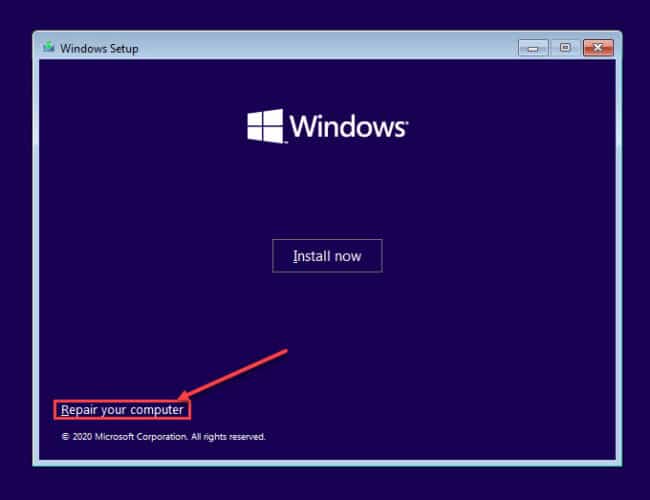
Now, navigate to the following location to launch the Command Prompt.
Troubleshoot -> Advanced options -> Command Prompt

Paste the following commands into Command Prompt one after the other to repair the BCD files.
bootrec /rebuildbcd bootrec /scanos bootrec /fixmbr
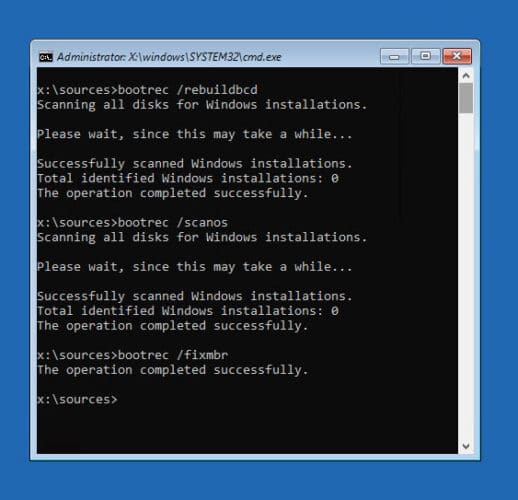
Now type in exit to leave the Command Prompt and then reboot the computer. Check to see if the OS loads up now.
Perform a clean install
If your OS still doesn’t boot properly but the hard drive is fully detectable by the OS, we regret to say that you must now reinstall your OS as it has been corrupted and is unfixable. Refer to this guide to create a bootable USB device for any version of Windows 10.
Final verdict
Unfortunately, if your OS does not boot up normally from BIOS, the option to restore it to a previous state also goes out of the window. There can be a number of reasons, as well as solutions, to fix the “reboot and select a proper boot device” prompt.
We believe that the issue can be resolved using the solutions provided in this post. Do let us know which one works for you in the comments below.

